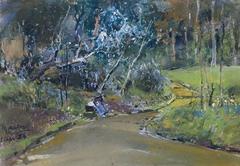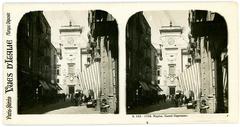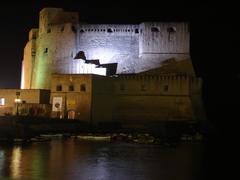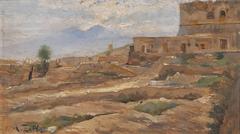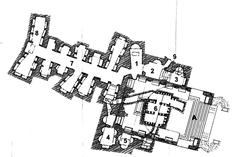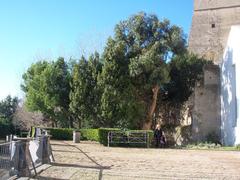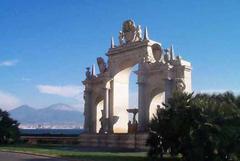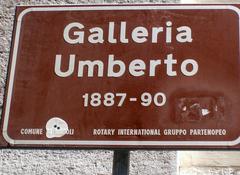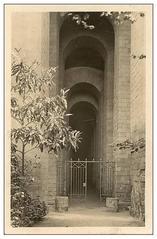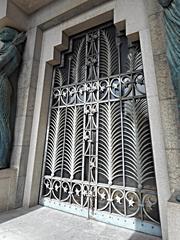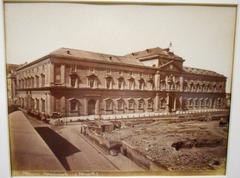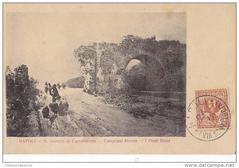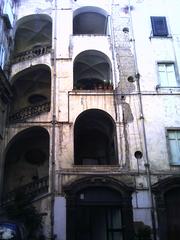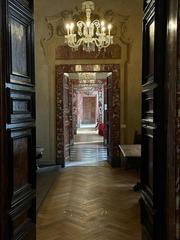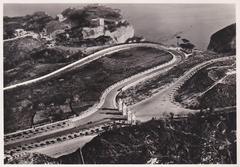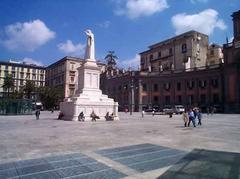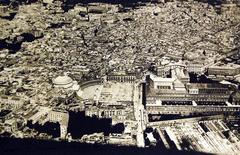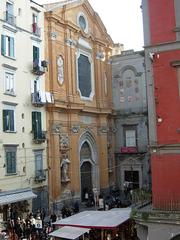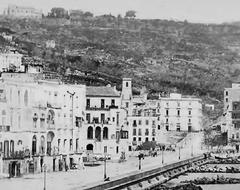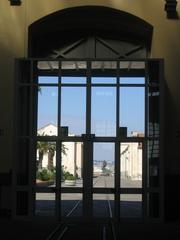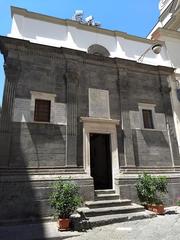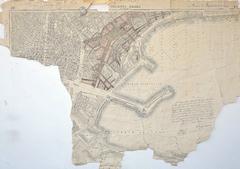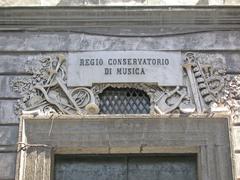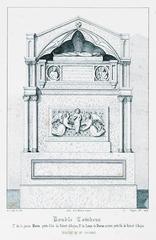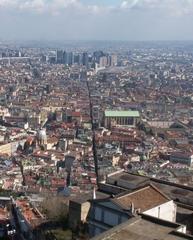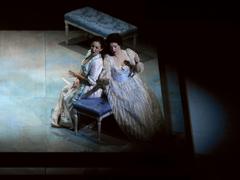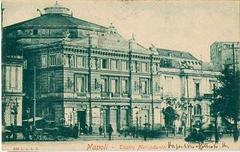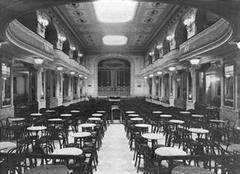Visiting Via San Biagio dei Librai: History, Tips, and Visitor Information
Date: 01/08/2024
Why Visit Via San Biagio dei Librai?
Via San Biagio dei Librai, a historic street in the heart of Naples, Italy, is an essential destination for anyone wishing to immerse themselves in the city’s rich cultural and historical tapestry. Part of the famous Spaccanapoli, this vibrant thoroughfare traces its roots back to ancient Greek and Roman times, forming part of the Roman decumanus inferior. Over centuries, it has evolved into a bustling center for commerce, literature, and artisanal crafts, seamlessly blending its storied past with the lively present. The street’s name, ‘Librai,’ meaning booksellers, reflects its historical association with the trade of rare and antique books. This guide will provide you with a comprehensive overview of Via San Biagio dei Librai, covering its historical significance, key landmarks, visitor information, and practical travel tips. Whether you’re a history enthusiast, a foodie, or an art lover, this guide will help you make the most of your visit to this iconic Neapolitan street (Italylogue, Renato Prosciutto).
Table of Contents
- Introduction
- Historical Background
- Key Landmarks
- Visitor Information
- Nearby Attractions
- Cultural Significance and Modern-Day Attractions
- Preservation Efforts and Future Prospects
- FAQ
- Conclusion
Introduction
Via San Biagio dei Librai, a vibrant street in Naples, Italy, offers a unique glimpse into the city’s rich historical and cultural heritage. From its ancient origins to modern-day attractions, this historic street is a must-visit for anyone exploring Naples. This guide provides comprehensive information on the history, visiting hours, ticket prices, and nearby attractions to help you plan your visit.
Historical Background
Ancient Origins and Roman Influence
Via San Biagio dei Librai, part of the famous Spaccanapoli, traces its origins back to the ancient Greek and Roman periods. The street runs along the path of the Roman decumanus inferior, one of the three main east-west roads that structured the ancient city of Neapolis. This grid layout, established by the Greeks and later adopted by the Romans, has significantly influenced the urban planning of Naples, making Via San Biagio dei Librai a crucial artery in the city’s historical and cultural landscape (Italylogue).
Medieval and Renaissance Periods
During the medieval period, Via San Biagio dei Librai became a prominent residential area for Naples’ aristocratic families. The street’s significance grew as it became a hub for commerce and trade. By the Renaissance, the street had evolved into a bustling center for booksellers, earning its name ‘Librai,’ which means booksellers in Italian. This period saw the construction of several important buildings and churches, many of which still stand today, reflecting the architectural styles of their times.
Key Landmarks
The Church of San Biagio Maggiore
One of the most notable landmarks on Via San Biagio dei Librai is the Church of San Biagio Maggiore. Constructed in the late 7th century, this baroque church was run by the booksellers’ guild from the 16th century onward. The church’s connection to the booksellers’ guild is commemorated by a plaque on the wall of the nearby Palazzo Marigliano (Renato Prosciutto). The church’s historical significance is further highlighted by its architectural features and its role in the cultural life of the street.
Palazzo Marigliano
Palazzo Marigliano, located at number 39 Via San Biagio dei Librai, is another significant historical building. Built in the late 15th century for the aristocrat Domenico Carafa, the palazzo is renowned for its architectural beauty and historical importance. The building’s facade features a ‘Madonella,’ a small religious image, which is a characteristic element of Neapolitan architecture (Renato Prosciutto).
The Ospedale delle Bambole
Founded towards the end of the 19th century, the Ospedale delle Bambole (Dolls’ Hospital) at number 81 Via San Biagio dei Librai is a unique establishment that reflects the street’s eclectic history. Luigi Grassi, a theater set designer, established the hospital to repair damaged theatrical dolls and puppets. The hospital has been run by Grassi’s family for four generations, making it a living testament to the street’s enduring cultural heritage (Renato Prosciutto).
The Church of Santi Filippo e Giacomo
Another significant religious site on Via San Biagio dei Librai is the Church of Santi Filippo e Giacomo. Originally commissioned by local merchants and tradesmen in 1593, the church underwent a major reconstruction in 1758 by Gennaro Papa. The church’s facade, designed in the concave/convex style reminiscent of Borromini, features statues by Giuseppe Picano and Giuseppe Sanmartino. The interior boasts frescoes by Jacopo Cestaro, adding to the church’s artistic and historical value (Wikipedia).
Visitor Information
Visiting Hours and Tickets
- Visiting Hours: Generally, the street is open all day, every day. Specific hours for landmarks such as churches and museums may vary, so it’s best to check in advance.
- Tickets: Entry to Via San Biagio dei Librai is free. However, some landmarks like the churches and museums may have entry fees ranging from €3 to €10.
Travel Tips
- Best Time to Visit: Early mornings and late afternoons are ideal to avoid the crowds. The street is especially busy during Christmas due to its famous nativity scene artisans.
- Getting There: Via San Biagio dei Librai is easily accessible by public transport. The nearest metro station is Dante on Line 1.
- Accessibility: The street is pedestrian-friendly but can be uneven in places, so comfortable walking shoes are recommended.
Nearby Attractions
- Naples Cathedral: A short walk from Via San Biagio dei Librai, this cathedral is a stunning example of Gothic architecture.
- San Gregorio Armeno: Famous for its nativity scene shops, this street is a must-visit for Christmas enthusiasts.
- Piazza del Gesù Nuovo: Home to the Church of Gesù Nuovo and the beautiful Spire of the Immaculate Virgin.
Cultural Significance and Modern-Day Attractions
Today, Via San Biagio dei Librai is not only a historical landmark but also a lively cultural hub. The street is lined with a mix of souvenir shops, artisanal workshops, and eateries, offering a glimpse into the daily life of Naples. Despite the commercialization, the street retains its historical charm, with many buildings and churches preserving their original architectural features.
The Role of Booksellers and Artisans
The legacy of the booksellers who once dominated Via San Biagio dei Librai is still evident today. Although many of the original bookstores have been replaced by souvenir shops and nativity scene (presepi) artisans, the street continues to celebrate its literary heritage. The presence of artisanal workshops, where craftsmen create intricate presepi figures, adds to the street’s unique character and cultural significance (Renato Prosciutto).
Preservation Efforts and Future Prospects
Efforts to preserve the historical and cultural integrity of Via San Biagio dei Librai are ongoing. Local authorities and cultural organizations are working to balance the needs of tourism with the preservation of the street’s heritage. Initiatives such as guided tours, cultural events, and restoration projects aim to enhance the visitor experience while safeguarding the street’s historical assets.
FAQ
Q: What are the visiting hours for Via San Biagio dei Librai?
A: The street is open all day, every day, but specific landmarks may have varying hours.
Q: Are there any entry fees for visiting Via San Biagio dei Librai?
A: Entry to the street is free, but some landmarks like churches and museums may charge entry fees ranging from €3 to €10.
Q: What is the best time to visit Via San Biagio dei Librai?
A: Early mornings and late afternoons are ideal to avoid crowds.
Q: How can I get to Via San Biagio dei Librai?
A: The street is easily accessible by public transport, with the nearest metro station being Dante on Line 1.
Conclusion
Via San Biagio dei Librai is a microcosm of Naples’ rich history and vibrant culture. From its ancient origins as a Roman decumanus to its modern-day role as a bustling tourist destination, the street embodies the dynamic and multifaceted character of Naples. Visitors to Via San Biagio dei Librai can immerse themselves in the city’s past, explore its architectural treasures, and experience the lively atmosphere that makes Naples a unique and unforgettable destination.
Call to Action
For more information on Naples and its historical sites, download our mobile app, Audiala. Check out our other related posts and follow us on social media for more updates.
References
- Italylogue, (n.d.), https://www.italylogue.com/featured-articles/spaccanapoli-naples-historic-main-street.html
- Renato Prosciutto, (n.d.), https://renatoprosciutto.com/via-san-biagio-librai-naples/
- Wikipedia, (n.d.), https://en.wikipedia.org/wiki/Santi_Filippo_e_Giacomo,_Naples
- Travelling Dany, (n.d.), https://www.travellingdany.com/naples-christmas-alley-via-san-gregorio-armeno/
- Visit Naples, (n.d.), https://www.visitnaples.eu/en/neapolitanity/walk-naples/christmas—streets-of-naples-san-gregorio-armeno-and-san-biagio-dei-librai
- TripSavvy, (n.d.), https://www.tripsavvy.com/the-best-things-to-do-on-spaccanapoli-naples-5096756
- Every Steph, (n.d.), https://www.everysteph.com/spaccanapoli-naples/
- Full Suitcase, (n.d.), https://fullsuitcase.com/naples-best-things-to-do/
